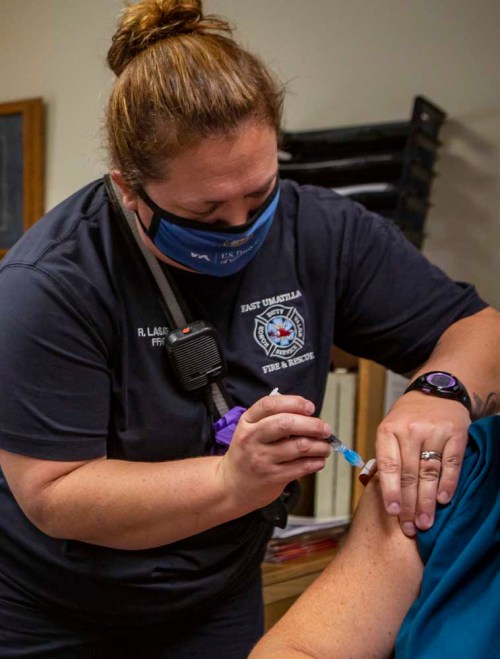Athena woman spearheads vaccine efforts in northeast Umatilla County
Published 5:00 am Thursday, September 9, 2021

- Registered nurse and firefighter Rachelle Lasater administers a dose of the Johnson & Johnson COVID-19 vaccine Tuesday, Sept. 7, 2021, at the East Umatilla County Ambulance Area Health District office in Athena.
PENDLETON — The protester accosted the people in Weston’s community hall as they waited to get their COVID-19 vaccine on a recent afternoon in late August.
Patients spoke up and pushed back, eventually forcing him outside to the street. A young patient looked nervously toward Rachelle Lasater, a registered nurse from Athena who was helping with immunizations that day. The woman was not mandated to get the shot, Lasater believes, but she was reluctant and had only recently changed her mind. Trepidatiously, she went through with her decision.
That moment has stuck in Lasater’s mind. She has mixed feelings about it. On one hand, she’s glad the young woman decided to receive a potentially life saving vaccine. On the other hand, she feels bad that the woman made her decision — a personal decision, Lasater said — under the shroud of political division, and Lasater didn’t want it to seem like she was forcing her.
“It was an uncomfortable situation,” said Lasater, 44. “I think we handled it professionally. Patients still received the vaccine. It felt good to meet people’s needs, but I also had my eyes opened to the other side — that people don’t want it, and they don’t want people to get it.”
Lasater has been at the forefront of COVID-19 vaccination efforts in some of Umatilla County’s smallest towns — Helix, Weston and Athena. Collectively, those three communities have a vaccination rate of just more than 50%, according to county health data.
Lasater estimates she has vaccinated nearly 300 people. That’s nearly 30% of all vaccines delivered in those three communities, according to county health data.
A registered nurse at East Umatilla Fire and Rescue and former employee of the Umatilla County Public Health Department, Lasater volunteered to bring vaccines to the towns in northeast Umatilla County, taking the reins from the health department in May. Working in ambulance services, she has witnessed patients fall victim to COVID-19, which motivated her to help bring vaccines to her community.
“When I transport a patient to the ER,” she said, “and (health care workers) are stressed and full to the brim with patients and they can’t hardly breathe because they have so many things going on, it makes me want to do more prehospital to help reduce the number of patients that are hospitalized. And there’s ways we can do that.”
Lasater has traveled to people’s homes for appointments, providing immunizations and vaccine information. She’s spearheaded clinics at elementary schools, local pools and community halls, at times working alone or on her days off. Sometimes, few people show up. Lately, the turnout has improved.
“She’s made so many sacrifices with so many clinics,” said East Umatilla Fire and Rescue Chief Dave Baty, adding that Lasater often will set aside six hours in a day for vaccinations.
“When others on our crew see that she’s setting up another clinic, they’re checking their schedule to see if they can help out,” Baty said. “She’s the head of the spear, and there’s a lot of people following her. Sometimes you have to break the trail, and after that, they’ll follow.”
She’s also seen the vaccine become more and more politicized in the communities she serves. And she said state and federal efforts to improve vaccination rates, like incentives and mandates, could be driving more people in rural communities away from getting the jab.
“If I could have them rewind, and if my voice meant anything to anyone in the upper parts of the state, I would say, ‘Don’t do that,’” she said. “If you want more people to get the vaccine, don’t coerce them with money and stuff, because that makes stuff seem suspicious. I think that’s what’s happening around here. People are unsure.”
COVID-19 vaccination rates in Umatilla County have increased gradually over the last month, but remain sixth lowest in the state at just under 50%. Meanwhile, the county has reported record-breaking COVID-19 case counts, hospitalizations and deaths during the past month amid the delta crisis that has rocked Oregon’s health care system.
“It’s not as intimate when Portland tells Pendleton or Athena this is how you have to do things,” she said of vaccines, adding, “I think it’s more intimate in these rural communities. They trust who they trust because that’s how it is out here. People just know what they know and trust who they’ve been going to. And if some bigger person comes in and says, ‘No, that’s not right, you have to do it this way,’ It’s hard for people to let go of that.”
Lasater also was reluctant to get the shot, but decided she wanted to do what she could to protect her loved ones from a disease that as of Sept. 7 killed 118 Umatilla County residents. She said she believes the vaccine is effective and that, if there was better vaccine education, more people may change their minds.
“It’s hard for people to know how to trust what they’re hearing, reading or seeing without taking time to look into it themselves,” Lasater said. She always points people toward reputable health sources such as the Centers for Disease Control and Prevention for information, and away from Facebook, a platform ripe with misinformation.
“I’m not sure a lot of people are willing or comfortable to do that,” she said. “Research is a lot of work and I don’t think people have that time.”
That’s why she’s passionate about informing her community, she says.
An example of localized efforts working, she says, is Helix. With less than 200 residents, the community has the highest percentage of residents vaccinated in the county, exceeding 70%, according to county data.
Lasater, along with local health care workers and local community groups, led two vaccine efforts at the Helix pool. Groups that participated in these efforts were the first to be rewarded in the county’s vaccine incentive program, which funds groups when the ZIP code encompassing the town reaches the 60% vaccine threshold.
“I feel that, being more personable as a health district, getting our faces out there and talking to people, has helped us direct people to resources,” Lasater said. “I think it’s helped them to trust us more, and when we’re doing clinics, they feel comfortable reaching out to us.”









